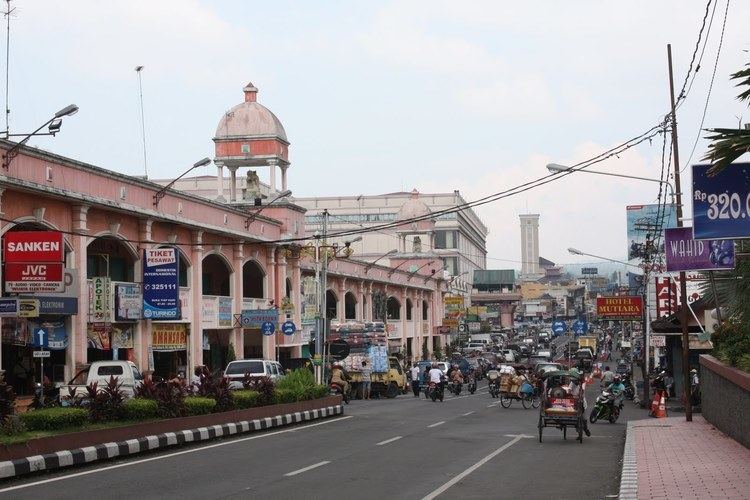Country Indonesia Area 17.87 km2 | Population 170,332 (2010) | |
 | ||
University Satya Wacana Christian University | ||
Map of Salatiga
Salatiga is a city in Central Java, Indonesia and located between the cities of Semarang and Surakarta. It sits at the foot of Mount Merbabu (3,142 m) and Mount Telomoyo, and has a relatively cool climate due to its elevated position.
Contents
- Map of Salatiga
- Semmy blank assassin at salatiga movement anniv 2015
- Grand wahid hotel salatiga
- Etymology
- History
- Administration
- Geography
- Demographics
- Religion
- Economy
- Transport
- Tertiary education
- Schools
- Works cited
- Salatiga guesthouse oase van java bb bed and breakfast
- References
Semmy blank assassin at salatiga movement anniv 2015
Grand wahid hotel salatiga
Etymology
Salatiga is thought to be named either after the goddess of Trisala, or after the three wrongs done to the first king of Semarang.
In the first explanation, the people of the village celebrate the goddess of Siddhadewi, which was mentioned in the Monolith of Plumpungan. Siddhadewi was also called Trisala, so the village was called Trisala and in the years to come became Salatri and eventually Salatiga.
The second explanation is based on the story of Ki Ageng Pandanaran, the first regent of Semarang, who was robbed by three muggers, and he thus named the location Salah Telu. Salah means wrong in both Indonesian and Javanese. Telu is Low Javanese for three, spelled is tiga in both the more refined Middle/High Javanese (but pronounced /tigo/ in Javanese respectively /tiga/ in Indonesian). Hence the name Salatiga from Salah Tiga.
History
The official birth date of Salatiga is 24 July 750 A.D. (the 31st date and 4th year of the Saka calendar). The scroll Monolith of Plumpungan (Prasasti Plumpungan in Sanskrit) by King Bhanu, declares May you be happy! All the people ("Srir = astu swasti prajabhyah") and designated village of Hampran (Desa Hampran) a Perdikan village (Desa Perdikan, meaning a tax-free village). "Çrirastuswasti Prajabyah" is the official motto of Salatiga as written in the government seal.
In 1746, the Dutch East India Company (Vereenigde Oost-Indische Compagnie, VOC) built De Hersteller fort in Salatiga because Salatiga was strategically located at the intersection between Semarang, Surakarta and Magelang.
On 1 July 1917 the village of Salatiga was designated as a stads gemeente or small town, by the Dutch East Indies government. In the colonial era, Salatiga was stratified by race. The Europeans live near the city centre, at the Toentangscheweg (Toentang Road) because it leads to Semarang and also near to Dutch plantations in the Salatiga Afdeling. The Chinese live near the trading centre, the Kalicacing Market, at the Soloscheweg (Solo Road). The native people live outside the European and Chinese communities. The education system was divided by race, with different schools for the Europeans, the Chinese and the natives. Salatiga was led by a burgermeester (mayor), assisted by College van Burgermeester en Wethouders. There was a legislative body, the Stadsgemeenteraad; however, its membership was not proportional, with 8 seats for the Europeans, 1 seat for the Far Easterners (represented by a Chinese), and only 2 seats for the natives who form the majority of the people. The birth of Salatiga was accompanied by the world economic depression of the 1930s, so the development of the city was halted, and to solve the increase of the city's spending, the salaries of government officials were cut by up to 15%. Salatiga had an important economic role as a hinterland to Semarang, providing products from coffee, rubber, cacao, cotton, spices, tobacco, wheat and vegetable plantations to Semarang to be processed.
Supported by geographical factors, its cool climate, and its luxurious buildings with Indic architecture, Salatiga's beauty was well-known during the Dutch colonisation, even it was called De Schoonste Stad van Midden-Java (The Most Beautiful City in Central Java).
Administration
Salatiga is divided into four subdistricts (kecamatan): Argomulyo, Tingkir, Sidomukti, and Sidorejo.
Bordering Salatiga are the following subdistricts:
All these districts are located in Semarang Regency, making Salatiga an enclave within Semarang Regency.
Geography
Salatiga is located about 47 km south of Semarang and about 100 km north of Yogyakarta. Its elevation is between 450–800 metres. Salatiga has a tropical monsoon climate (Am) in the Köppen climate classification with the average rainfall of 2,668 mm per year, the highest temperature in October (24.1°C) and the lowest in January (22.4°C).
Demographics
As of 2015, Salatiga has a population of 183,815, 89,928 of them are males and 93,887 are females.
Religion
As of 2015, Islam was the most practised religion in Salatiga (78%), followed by Protestantism (16%) and Catholicism (5%). Other religions (Buddhism, Hinduism, Confucianism and aliran kepercayaan) make up less than 1% of the population. Salatiga is well-known for its religious tolerance and is one of the few cities in Java to hold outdoor Christian festivals during Christmas.
Economy
There is an emerging processing industry, that includes textile, tires and animal slaughter. In 2000, this industry contributes 119.76 billion rupiahs to the economy of Salatiga. Salatiga is located at the intersection to and from Semarang, Surakarta and Yogyakarta, benefiting its trade sector. In 2000, the trade sector contributes 109 billion rupiahs to the economy of Salatiga.
Transport
Tingkir Terminal is the main bus station in Salatiga, serving intercity buses. The Tamansari Terminal serves angkot (share taxis), even though most of the angkot did not stop at the terminal.
Tertiary education
Salatiga has several universities and colleges:
Schools
There are 96 elementary schools, 24 junior high schools, 8 senior high schools, and 19 vocational schools in Salatiga. Schools in Salatiga are normally affiliated with the government, universities, or religious institutions. In the past, state-run schools are generally sought after for their quality and subsidised cost however this had changed significantly. Students also generally compete by using final examination grades and written examinations to enter the more popular schools.
Salatiga has one international English-speaking school at elementary and secondary level (Mountainview International Christian School).
